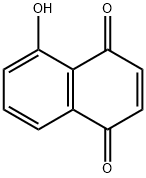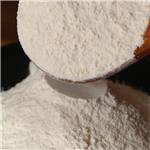Juglone (5-hydroxynapthoquinone), is found in the
leaves and other parts of walnut, hickory and pecan (1,2).
Juglone is synthesized from isochorismic acid (a product
of the shikimic acid pathway) and 2-oxo-glutaric acid (3).
In plant tissue juglone exists as a free compound or
as a glycoside (3,4). Action of a glucosidase releases 1,4,5-trihydroxynapthalene, which is then oxidized to
juglone (3,4).
Juglone is a natural naphthoquinone found in the black walnut (J. nigra) and other plants in the Juglandaceae family. It has allelopathic actions, suppressing growth, photosynthesis, and respiration in plants and other organisms, although some bacteria can metabolize juglone. Juglone also irreversibly inhibits peptidyl-prolyl cis/trans isomerases of the parvulin family, including human Pin1, yeast Ess1/Ptf1, and E. coli parvulin (Ki = 55.9 nM). Juglone also blocks transcription by RNA polymerases I, II, and III (IC50s = 2-7 μM) and attenuates kidney fibrosis in rats treated with unilateral ureteral obstruction, both through Pin1-independent mechanisms.
Orange to brown crystalline powder
antineoplastic, antifungal, antioxidant, Pin 1 inhibitor
5-Hydroxy-1,4-naphthoquinone is used as a natural dye in cloth, fabrics, wool and ink. It is a coloring agent for food and cosmetics. It is involved in the synthesis of poly(hydroxyl-1,4-naphthoquinone) stabilized gold nanoparticles (AuNQ NPs), which is used for nonenzymatic electrochemical detection of glucose.
Juglone (CI Natural Brown 7; CI 75500) was isolated from the husks of walnuts in 1856. Juglone occurs in walnuts as a glycoside of its reduced form, 1,4,5-trihydroxynaphthalene. Its structure is (3) Juglone is most readily synthesized by Bernthsen s method. It is a fungicide and as such finds use in the treatment of skin diseases. Its toxic properties have been made use of in catching fish. Juglone has been used to detect very small amount of nickel salts since it gives a deep violet color with such salts.
ChEBI: A hydroxy-1,4-naphthoquinone that is 1,4-naphthoquinone in which the hydrogen at position 5 has been replaced by a hydroxy group.
This substance is a primary reference substance with assigned absolute purity (considering chromatographic purity, water, residual solvents, inorganic impurities). The exact value can be found on the certificate. Produced by PhytoLab GmbH & Co. KG
Juglone is probably best known as the allelochemical
produced by black walnut. The glucoside of juglone leaches
from the leaves and branches of black walnut, where it
is converted to juglone in the soil. Juglone is toxic to
certain plant species and also inhibits the germination of
seeds (4). Thus its allelopathic activity may be the result
of both phytotoxicity and a germination inhibitor.
Juglone is also antifungal (1,5) and attempts to
correlate its presence with disease resistance in pecan,
black walnut, and hickory to several fungal pathogens
have been reported (1,2,5,6). Positive correlations have
been found for resistance of juvenile leaves of black walnut
to anthracnose caused by Gnomia leptostyla (5) and of
some Carya species to the scab pathogen Cladosporium
carygenum (2). In some pecans (C. illinoensis), juglone
may act as both a preformed and an induced defense factor
because concentrations of juglone increase after infection
by fungi (2). No correlation between juglone glycoside
concentration in pecan leaves and resistance pecan to
C. carygenum has been reported (6). Free juglone and the
glycosides increase after infection, but these increases
could not be correlated with scab resistance (6).
Crystallise Juglone from *benzene/pet ether or pet ether. [Beilstein 8 III 2558, 8 IV 2368.]
[1] A A HEJL J A R F A Einhellig. Effects of juglone on growth, photosynthesis, and respiration.[J]. Journal of Chemical Ecology, 1993, 19 3: 559-568. DOI:
10.1007/bf00994325[2] LARS HENNIG. Selective Inactivation of Parvulin-Like Peptidyl-Prolyl cis/trans Isomerases by Juglone?[J]. Biochemistry Biochemistry, 1998, 37 17: 5953-5960. DOI:
10.1021/bi973162p[3] SHENG-HAO CHAO D H P A Greenleaf. Juglone, an inhibitor of the peptidyl-prolyl isomerase Pin1, also directly blocks transcription.[J]. Nucleic Acids Research, 2001, 29 3 1: 767-773. DOI:
10.1093/nar/29.3.767[4] SHANNON REESE. The Pin 1 inhibitor juglone attenuates kidney fibrogenesis via Pin 1-independent mechanisms in the unilateral ureteral occlusion model.[J]. Fibrogenesis & Tissue Repair, 2010: 1. DOI:
10.1186/1755-1536-3-1



